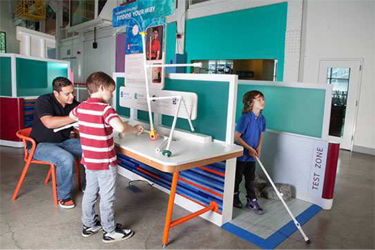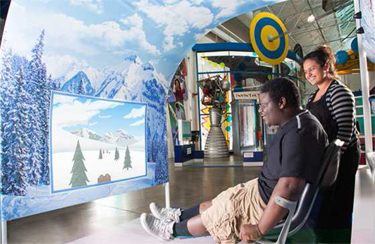Human +
Human + is a 2,500-sq. ft. traveling engineering exhibition developed by the New York Hall of Science (NYSCI) in collaboration with the Oregon Museum of Science and Industry (OMSI) and the Quality of Life Technology Research Center (QoLT) at Carnegie Mellon University and the University of Pittsburgh. Human+ is funded by a National Science Foundation (NSF) AISL grant (DRL-1010507).
The exhibit focuses on technologies designed to augment people’s abilities and the creative, user-centered process that’s used to develop these technologies. Human + communicates that people’s abilities are on a continuum, and that all people use technology to enhance them. From this perspective everything from eyeglasses to cellphones to wheelchairs and artificial limbs are prosthetics. As technology advances, the definition of assistive technology will continue to change, along with the idea of disability itself.
To that end, people with disabilities guided some of the process of developing the project. The exhibition has been designed to have visitors see themselves as personal users of technology to enhance their abilities, and as agents who can take a proactive role in designing something for themselves and others. Design challenges are incorporated throughout the exhibit.
Research Background
The inspiration for Human + is derived from an experience that I had with our daughter, Lili, who has Cerebral Palsy. When Lili was 10, she and I met with a designer to try to imagine new approaches to improving her mobility. In the course of our conversation, it became clear that Lili and the designer had different ideas about what was possible in the design of a new mobility device. This raised for me the overall question of how end-users of technology can influence the devices they use, whether those are prosthetics, assistive technology, or the latest cell phone or software.
Through this line of thought, we were fortunate to connect with Quality of Life Technology Research Center (QoLT), a consortium between engineers at Carnegie Mellon University and clinicians and researchers at the University of Pittsburgh. Their focus was what one of the QoLT founders, Dr. Rory Cooper, called Participatory Action Design, a cycle of design that deeply integrates the user. [1] Dr. Cooper, who uses a wheelchair, focuses Participatory Action Design on addressing the challenges of people who have limited mobility, sight, and hearing.

Finding Your Way at Human + exhibit.
Through our research, we were surprised to find that user involvement in engineering design is the exception rather than the rule, and that user-centered design was an emerging approach to engineering design. Specifically applied to design for assistive devices, the value of user-centered design is a subject of considerable research in the engineering field over the last decade. [2]
It was interesting to the exhibition development team to note the parallels between the rise in participatory design for engineering and a similar direction in the design of science, technology, engineering and math (STEM) learning experiences. Museums are experimenting with "talk back" elements, visitor-contributed content, and flexible exhibits that are changed or created by visitors. [3] Human + applied participatory design principles developed in engineering to create informal learning experiences, as recommended by the National Research Council in its report on informal science learning [4].
In addition, research on the participation of women in engineering suggested that girls would be more drawn to engineering if it were seen as a more human and humane undertaking. To address these issues, the National Academy of Engineering tested a set of new messages for improving public perception of engineering. Changing the Conversation: Messages for Improving Public Understanding of Engineering proposed a new lexicon with less emphasis on skill in math and science and more on “making a world of difference.” [5]
Designing the Exhibition

Overview of Human + exhibit.
Reflecting the design cycle of Participatory Action Design, Human + integrated extensive input from people with disabilities, both as users and as designers of technology. The planning team included a core group of exhibition developers from NYSCI and OMSI; three young people with mobility disabilities (including Lili Siegel, who recently graduated from Smith College); three participants from QOLT, including two engineers with disabilities; content experts; and evaluators. The team was tasked with designing an exhibit that got visitors to think about:
- How technology can augment people's abilities, including their own.
- What they have accomplished, and what their goals, abilities, and obstacles are.
- How they've modified or imagined modifying technology to make it work better for themselves.
- How they themselves design this technology.
Evaluation
Formative and summative evaluations were conducted by the Lifelong Learning Group at the Center for Research and Evaluation, led by Dr. Joseph Heimlich. The summative evaluation focused on two aspects of the project: the impact of participatory design on the group that contributed to the process and on the exhibition itself, and the effectiveness of the exhibition in meeting its learning goals.

Every Body Plays station in Human + exhibit.
Participant Research. The development process resounded strongly with the participants, and the design challenge ideas from discussions, specific situations, and stories shared throughout the planning process informed the exhibition experience. For example, the underlying and continually emerging theme of individual stories had an important influence on the narratives used in the final exhibit. The team also reflected on the impact that this process had on their own lives, reporting that their participation built new understanding and new connections, and was a source of pride. They found the fact that their ideas were clearly translated for broader audiences to be particularly compelling.
Exhibition Research. Summative evaluation suggested that the exhibition was successful in meeting its intended learning outcomes. In general, visitors left the exhibition with increased awareness of and appreciation for the engineering process, as well as an expression of interest in engineering. This attitude was even more pronounced among respondents answering in retrospect, several weeks later.
Dissemination and Broader Impact
Human + has been featured in peer-reviewed articles, online media, and conference discussions. The exhibition’s touring schedule is nearly full and it will be seen by millions of visitors at eight science centers across the U.S.
By building a strong relationship between the engineering research center led by Rory Cooper, Human + will continue to serve as a model of collaboration between informal learning organizations and STEM practitioners. One other aspect of the project was a collaboration with the designer John Schimmel, who has built a website called accesstogether.org, which uses a Foursquare-style interface to invite people to rate and comment on the accessibility of facilities in their own communities. So far, thousands of sites have been rated, and we are hoping that visitors at each local venue where Human + is exhibited will rate the facilities in their neighborhoods.
For me, Human +, as its title suggests, re-integrates qualities of empathy and narrative into STEM learning. Every day we are reminded that science is a very human undertaking, and I hope that programs like Human +, along with groundbreaking exhibitions like Race: Are we So Different?, will help visitors understand that STEM is part of the human enterprise, and part of their own lives. As we are all users of technology to improve our abilities (whether it’s eyeglasses or bicycles or prosthetic legs), it becomes increasingly compelling to understand our relationships to technology and build a more compelling rationale for participating actively in STEM.
References
[1] Ding, Dan, Cooper, Rory, and Pearlman, Jon. "Incorporating participatory action design into research and education." International Conference on Electrical Engineering. 2007.
[2] Christ, O. et al. User-Centered Prosthetic Development: Comprehension of Amputees’ Needs. Biomed Tech 2012; 57, 2012 Berlin/Boston.
[3] McLean, K. and Pollock, W. Visitor Voices in Museum Exhibitions. Association of Science-Technology Centers, 2007.
[4] National Research Council. Learning Science in Informal Environments: People, Places, and Pursuits. Washington, DC: The National Academies Press, 2009.
[5] National Academy of Engineering. Changing the Conversation: Messages for Improving Public Understanding of Engineering. Washington, DC: The National Academies Press, 2008.
All images c/o OMSI, provided by the author.